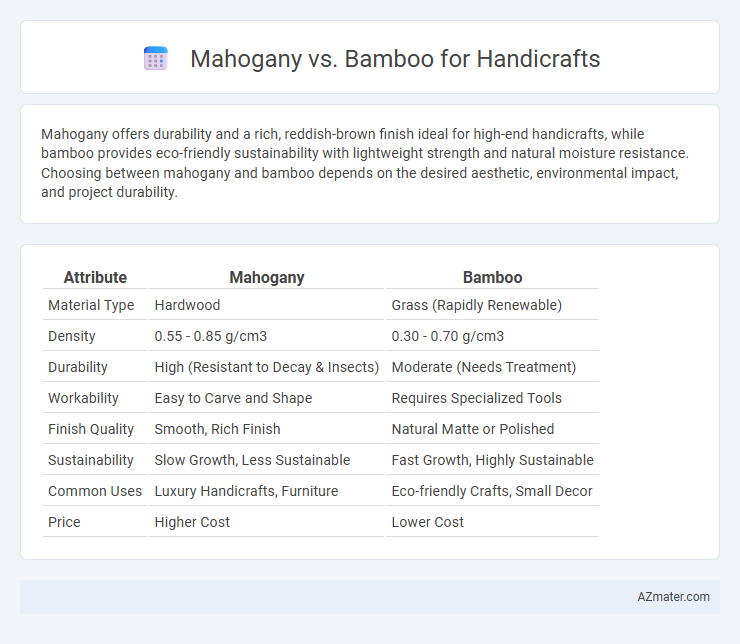Mahogany offers durability and a rich, reddish-brown finish ideal for high-end handicrafts, while bamboo provides eco-friendly sustainability with lightweight strength and natural moisture resistance. Choosing between mahogany and bamboo depends on the desired aesthetic, environmental impact, and project durability.
Table of Comparison
| Attribute | Mahogany | Bamboo |
|---|---|---|
| Material Type | Hardwood | Grass (Rapidly Renewable) |
| Density | 0.55 - 0.85 g/cm3 | 0.30 - 0.70 g/cm3 |
| Durability | High (Resistant to Decay & Insects) | Moderate (Needs Treatment) |
| Workability | Easy to Carve and Shape | Requires Specialized Tools |
| Finish Quality | Smooth, Rich Finish | Natural Matte or Polished |
| Sustainability | Slow Growth, Less Sustainable | Fast Growth, Highly Sustainable |
| Common Uses | Luxury Handicrafts, Furniture | Eco-friendly Crafts, Small Decor |
| Price | Higher Cost | Lower Cost |
Introduction to Mahogany and Bamboo in Handicraft
Mahogany and bamboo are popular materials in handicrafts due to their unique properties and aesthetics. Mahogany offers a rich, reddish-brown color and fine grain, making it ideal for high-quality furniture, carvings, and decorative items with durability and elegance. Bamboo is valued for its lightweight, flexibility, and eco-friendly characteristics, frequently used in weaving, baskets, and sustainable craft products.
Material Characteristics: Mahogany vs Bamboo
Mahogany offers a dense, durable hardwood ideal for detailed carving and long-lasting handicrafts, featuring a rich reddish-brown color that enhances aesthetic appeal. Bamboo, a fast-growing grass, provides lightweight, flexible material with excellent tensile strength and natural resistance to moisture, making it suitable for eco-friendly, sustainable crafts. The choice between mahogany and bamboo depends on the desired balance between durability, texture, and environmental impact for handcrafted products.
Sustainability and Environmental Impact
Mahogany, a slow-growing hardwood, often faces deforestation pressures, negatively impacting biodiversity and carbon sequestration. Bamboo, a rapidly renewable grass, absorbs more CO2 and requires fewer pesticides and water, making it a highly sustainable choice for handicrafts. Choosing bamboo over mahogany significantly reduces environmental impact through faster regeneration and lower ecological footprint.
Durability and Longevity in Handicrafts
Mahogany offers exceptional durability and resistance to wear, making it ideal for high-quality, long-lasting handicrafts that require strength and fine detail. Bamboo, while less dense, provides impressive longevity due to its natural flexibility and rapid regenerative properties, making it suitable for eco-friendly, lightweight crafts. Both materials excel in durability, with mahogany favored for heavy-duty applications and bamboo preferred for sustainable, versatile designs.
Aesthetic Appeal: Color, Texture, and Grain
Mahogany offers a rich reddish-brown color with a smooth, fine texture and straight, tight grain, making it ideal for elegant, classic handicrafts. Bamboo features a light, natural golden-yellow tone with a distinctive smooth texture and a uniform, linear grain pattern, lending a modern, eco-friendly look. Both materials provide unique aesthetic appeals, with mahogany emphasizing warmth and sophistication while bamboo showcases simplicity and sustainability.
Workability and Crafting Techniques
Mahogany offers excellent workability due to its fine grain and stability, making it ideal for detailed carving and fine finishes in handicraft projects. Bamboo's unique fibrous structure allows for flexible bending and weaving techniques, commonly used in intricate basketry and furniture crafting. Both materials require distinct tools: mahogany benefits from sharp chisels and sanding for smooth surfaces, while bamboo demands specialized cutters and steam treatments to enhance its pliability during crafting.
Cost Comparison: Mahogany vs Bamboo
Mahogany is significantly more expensive than bamboo due to its slower growth rate and limited availability, making it a premium choice for high-end handicrafts. Bamboo offers a cost-effective alternative, reflecting its rapid renewability and widespread abundance, which lowers raw material expenses. When comparing cost efficiency for large-scale handicraft production, bamboo provides substantial savings without compromising durability or aesthetic appeal.
Popular Handicraft Applications
Mahogany's rich grain and durability make it ideal for intricate wood carvings, decorative boxes, and traditional furniture, favored in luxury handicrafts. Bamboo's lightweight, flexibility, and rapid growth suit it for woven baskets, mats, and eco-friendly home decor items popular in sustainable craft markets. Both materials are valued for their aesthetic appeal and versatility, with mahogany preferred in high-end, detailed crafts and bamboo dominating eco-conscious, functional designs.
Maintenance and Care Requirements
Mahogany requires regular polishing and protection from moisture to prevent warping and maintain its rich color, whereas bamboo demands minimal upkeep with occasional wiping and avoidance of prolonged water exposure. Both materials benefit from keeping away from direct sunlight to prevent fading, but bamboo's natural resistance to insects and mold makes it easier to maintain over time. Using appropriate sealants extends the lifespan of mahogany handicrafts, while bamboo often needs less frequent treatment due to its inherent durability and sustainability.
Choosing the Right Material for Your Handicraft Project
Mahogany offers rich color and durability ideal for detailed carving and long-lasting handicrafts, while bamboo is lightweight, sustainable, and flexible, perfect for eco-friendly and intricate weaving projects. Consider the project's purpose and finish: mahogany provides a smooth, polished appearance with excellent strength, whereas bamboo's natural texture supports unique, organic designs and easier shaping. Selecting mahogany suits fine furniture or decorative items needing robustness, whereas bamboo is best for lightweight, environmentally conscious crafts requiring versatility.

Infographic: Mahogany vs Bamboo for Handicraft
 azmater.com
azmater.com